 |
Abe Lincoln’s Dream Lane Smith When Quincy wanders from her tour in the White House, she meets the ghost of Abraham Lincoln. Lincoln tells her about a dream he had. She decides it is time for him to leave the Executive Mansion (now called the White House) and see for himself what has become of the United States of America. From the opening pages showing several presidential dogs’ reactions to the Lincoln bedroom, to illustrations of kids in stovepipe hats, an exaggeratedly lanky Lincoln, and a trip across America and to the moon, Smith grabs the reader. Toss in some corny jokes and inspirational ideas, and you have a book that will intrigue the reader even after multiple readings. The typefaces used for the text are reminiscent of nineteenth century newspapers, posters, and handbills. The muted palette illustrations, in pen-and-ink, oil, and digital, have occasional pops of color. Although the widest audience will be elementary school children, high school American History teachers who share this with their students will find many points for discussion. Who will be able to resist quoting Lincoln’s line: “Three cheers and ballyhoo!” Lincoln’s dream of a sailing ship also brings to mind Walt Whitman’s poem, “O Captain! My Captain.” Recommended reading for everyone. While humorous and upbeat, this ghost story has substance. 2012, Roaring Brook Press, Ages 5 to 10, $16.99. REVIEWER: Sharon Salluzzo (Children’s Literature). ISBN: 9781596436084 |
 |
Abraham Lincoln and Frederick Douglass: The Story Behind an American Friendship Russell Freedman The winner of the Newbery Medal for Lincoln: A Photobiography returns to his award-winning subject to focus attention on the history-making friendship between two self-made men whose stances against slavery changed American history forever. Freedman provides numerous parallels between the lives of these two American icons, most strikingly that both studied the book The Columbian Orator, “a collection of speeches and dialogues about freedom, democracy, and courage,” as preparation for becoming two of the most stirring orators of the nineteenth century. An escaped and then freed slave, Douglass abhorred slavery; Lincoln’s first exposure to slavery sickened him, but his political career was initially built around halting the expansion of slavery rather than abolishing it completely. Lincoln welcomed Douglass to the White House, the only black man bold enough to seek an audience with the president: “Mr. Douglass, I know you Sit down, I am glad to see you.” Lincoln heard, and heeded, Douglass’s complaints about unequal treatment of black soldiers in the Union army; Douglass came to understand why Lincoln, facing unbearable political pressures, had been slow to take the decisive step of emancipation. The two men forged a lasting friendship based on their intersecting goals: “Douglass needed Lincoln’s help to rid the nation of slavery. Lincoln needed Douglass to help him end the war and reunite the nation.” Freedman’s book is enormously readable, engaging, inspirational, and moving. Illustrated with numerous period photographs and drawings, the book also contains a list of relevant historic sites to visit, selected bibliography, source notes, and index. 2012, Clarion, Ages 8 to 14, $18.99. REVIEWER: Claudia Mills, Ph.D. (Children’s Literature). ISBN: 9780547385624 |
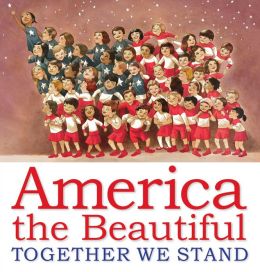 |
America the Beautiful: Together We Stand Katharine Lee Bates Illustrated by Bryan Collier et al Each line of the familiar song is according a two-page spread and accompanied by an image from one of ten different illustrators, as well as an American symbol and a presidential quote. Sonia Lynn Sadler’s artwork accompanying the line “Above the fruited plain!” shows a diverse group of individuals working on a quilt. Accompanying this is the Liberty Bell placed atop a quote from Abraham Lincoln’s Gettysburg Address. With each turn of the page, the reader sees the people and places of America as envisioned by these ten well-known illustrators: Bryan Collier, Raul Colon, Diane Goode, Mary Grandpre, John Hendrix, Yuyi Morales, Jon J. Muth, LeUyen Pham, Sonia Lynn Sadler, and Chris Soentpiet. There is an incredible amount of creativity and hopefulness apparent on these pages. Students can research the source of the quotes. Each individual element (e.g., illustration, symbol, and quote) lends itself to discussion, as does the double-page spread taken as a whole, and, for that matter, the entire book. Backmatter provides explanations of the symbols. Inside of the book jacket is a poster of all the U. S. presidents. Included are the words to four verses of America the Beautiful, although without the tune. 2013, Orchard Books, Ages 7 to 10, $17.99. REVIEWER: Sharon Salluzzo (Children’s Literature). ISBN: 9780545492072 |
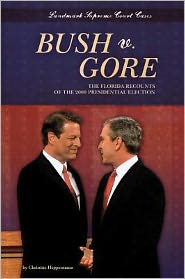 |
Bush V. Gore: The Florida Recounts of the 2000 Presidential Election Christine Heppermann Any reader interested in politics and American history has eagerly awaited an account of the most hotly contested election in U.S. history. Readers will be pleased by the readability of the text and the clarity of the explanations. Photo credits are numerous as expected as part of the “Landmark Supreme Court Cases” series. Books in this series examine the history-making discussions of the Court and the background of each landmark ruling case. Leading characters are described along with the country’s political climate. Heppermann’s book includes extensive Source Notes, a Timeline of Events and Rulings, along with a Glossary and Significant Briefs which contain a Summary of Impacts. Young readers wishing to discover more information and points of further exploration will find an excellent source herein. Heppermann is an experienced columnist, author and reviewer of children’s and adult literature. Richard Friedman, her content consultant, has a distinguished educational background and is a law professor and expert on Supreme Court history. The key to the 2000 Presidential Election lay in the candidate’s ability to capture Florida’s 25 electoral votes. Unfortunately the final result and tabulations were very slow to be released, much to the discomfort of many American voters who watched and waited. The writing in the book captures the tension and frustrations of many who could not believe the final results. Glossy photographs help to enliven the tension of the hours, days and weeks. High school and young adults will welcome the opportunity to sense Americans’ concerns about the fairness of voting procedures and the right of all Americans to have their vote officially registered. The last chapter “The Legacy of Bush v. Gore” should be discussed both with writing assignments, and orally in every United States classroom. It teaches lessons too valuable to be ignored. 2013, Abdo Publishing Co, Ages 14 to 18, $35.64. REVIEWER: Enid J. Portnoy (Children’s Literature). ISBN: 9781617834714 |
 |
The Camping Trip That Changed America: Theodore Roosevelt, John Muir, and Our National Parks Barbara Rockenstock In 1903, President Theodore Roosevelt wrote to naturalist John Muir asking Muir to take him on a camping trip to California’s Yosemite wilderness so he could see for himself the endangered sequoia trees that Muir loved so much. When Muir accepted, Roosevelt took off for the West. Tall, thin Muir and short, stocky Roosevelt make a picturesque pair as they gallop uphill on horseback, hair and horsetails flying on their way to the trees and mountains. Rosenstock has used primary sources to recreate conversations Muir and Roosevelt might have had as they camped together, beginning in the ancient Mariposa Grove of towering sequoias, captured in an elongated vertical spread. Cartoon panels enliven Muir’s comic story–told as they bed down under the great Grizzly Giant–of his encounter with a bear. The story has a point, however: grizzlies are extinct in Yosemite. The pair camp at rugged Glacier Point, while Muir explains how the wilderness was formed and readers see their crazy delight as they wake covered with white flakes from an overnight storm. “Bully!” cries Teddy, “What a glorious day!” As they ride on through the impressive Yosemite Valley, viewing huge granite formations like Half Dome and El Capitan, Muir continues his tuition, warning of indiscriminate mining, logging, and development (shown in a shadowed frieze). Over mugs of campfire coffee, Roosevelt is convinced that this land must be protected forever. Through energetic action, he created national parks and forests, wildlife sanctuaries, and wilderness areas, while the two campers became admirers and lifetime correspondents. Caldecott-medalist Gerstein’s vigorous, shimmering ink and watercolor illustrations capture both the grandeur of nature and the camaraderie of two unusual men, revealing the ideal blend of illustration and imaginative text that makes a true picture book a special work of art. 2012, Dial, Ages 7 to 11, $16.99. REVIEWER: Barbara L. Talcroft (Children’s Literature). ISBN: 9780803737105 |
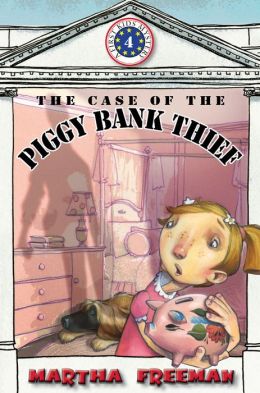 |
The Case of the Piggy Bank Thief Martha Freeman Cammie and Tessa, the creative and energetic daughters of the President, are experts at tracking and retrieving their errant pets from around the White House. They know all the back routes to track and recover missing items–or dog, or canary. But when Tessa’s piggy bank disappears the day after she finds a gold coin during an archeology dig and secrets the coin in her piggy bank, the girls have a real mystery on their hands! Who knew how to find Tessa’s piggy bank? And how did the thief know she had an invaluable gold coin hidden in it? This installation of the “First Kids’ Mysteries” series is entertaining and the plot moves at a good clip, but the sub plots and stories about the characters are just as much fun to read as the mystery. The stories about Tessa and Cammie dealing with escaping pets, their friend sneaking the dog jelly beans, and the girls’ frustrations about having to complete their regular chores when they would just rather be solving a mystery on Saturday is what makes it a great read: showing the girls of the President as regular kids, trying to grow up and have fun and learn, just as they would if they were not the children of a world leader. Readers will enjoy the energetic story of piggy bank crime and shenanigans in the world of the “first kids.” 2012, Holiday House, Ages 7 to 10, $16.95. REVIEWER: Caitlyn Payne (Children’s Literature). ISBN: 9780823425174 |
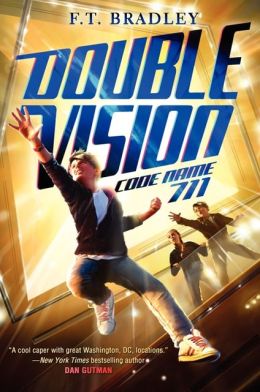 |
Double Vision: Code Name 711 F. T. Bradley Twelve-year-old Lincoln “Linc” Baker is a junior secret agent with the CIA. He thought he was done with the CIA after his last mission in Paris, but now he is asked to be on another mission to protect the President of the United States and her family. President Griffin received a communication that she and her family will be killed at a presidential ball in a few days, which means that Linc has three days to save the first family. He makes up a story so his parents will let him go from his home in Lompoc, California to Washington, D.C. Since the presidential ball is to honor Celebrating America’s History Week, attendees will wear period costume. The bad guy will attend and wear the Dangerous Double, the original coat that George Washington wore that makes its wearer invincible, but Linc must capture the coat before the bad guy and Ben, Linc’s nemesis. With the help of Henry, Linc’s gadget guy, Linc, and Amy, the first daughter, go on an adventure that includes meeting several people who give them clues to the Dangerous Double that lead them to the bad guy. This may be Linc’s most important mission yet. This action packed thriller will leave young readers wanting more while learning about the history of and historical sites in the nation’s capital. Harper/HarperCollins, Ages 8 to 12, $16.99. REVIEWER: Tina Chan (Children’s Literature). ISBN: 9780062104403 |
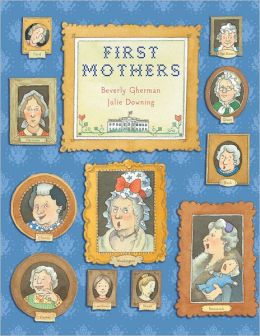 |
First Mothers Beverly Gherman Illustrated by Julie Downing Gherman takes readers on a quick stroll through this gallery of presidential mothers, pausing to speculate on the kind of influence each woman may have had on her son. A unique adjective in the heading of each entry encapsulates a notable trait: “The Affectionate Mother” of James Madison was known for her warmth and social egalitarianism; “The Brave Mother” of Andrew Jackson helped negotiate her captured sons’ release in the Revolutionary War; “The Protective Mother” of Rutherford Hayes “decided to educate Ruddy and his sister at home, rarely letting them out of her sight.” Most entries comprise a single page, but some share space and a few earn a double spread. Downing’s art varies from realistic historically tinged images to the funny but respectful cartoon style of Michael Emberly. Brief comic-book panels make an occasional appearance, and First Mother Mary Ball Washington (not a candidate for Mother of the Year) sticks her opinionated head in from time to time. A bibliography is appended. It remains now to be seen whether this book will last another four years, or require a revised edition as of November 6th. 2012, Clarion, Grades 3-5, $17.99. REVIEWER: Elizabeth Bush (The Bulletin of the Center for Children’s Books). ISBN: 9780547223018 |
 |
The House That George Built Suzanne Slade Illustrated by Rebecca Bond Slade (Climbing Lincoln’s Steps) delivers a historical riff on “The House That Jack Built” with this tale of how George Washington oversaw the construction of what would come to be called the White House: “This is the lot,/ that grand, ?scenic spot,/ for the President’s House that George built.” On most of the right-hand pages, the cumulative verse grows longer, while prose sections at left offer facts about materials, workers, and the house’s overall progress as it moves from blueprint to bricks-and-mortar reality; for instance, when the stone supply fell short, “George changed the house plan from three stories to two.” In airy watercolor-and-ink illustrations, Bond (In the Belly of an Ox) depicts the stages of construction and captures details of the era’s building methods and styles of dress; John and Abigail Adams, the building’s first residents, are shown looking around nervously upon moving in (“the plaster walls were still wet, and the winding staircase had only a few steps”). A foreword, author’s note, and additional White House facts supply even more details and context to this focused and well-executed project. 2012, Charlesbridge, Ages 6-9, $16.95. REVIEWER: Publishers Weekly ISBN: 9781580892629 |
 |
Looking at Lincoln Maira Kalman A whimsical picture-book look at the life of Abraham Lincoln is fresh and surprising, offering up facts about the most famous president in an offbeat story in which the narrator, a girl who is reading about Lincoln at the library, also conjectures about some of the things that aren’t known. “On the day he was elected, I bet Mary made his favorite vanilla cake.” There’s a loose chronological order to the somewhat stream-of-consciousness narrative, as in, “One day he was kicked in the head by a mule. He slept for two days. Then he woke up and grew up and decided to be a lawyer. (He did like to argue.)” Short paragraphs comprise the notes at the end, which expand on details mentioned in the text (e.g., “Mary Todd first baked a vanilla-almond cake for Abraham Lincoln when they were courting”). A bibliography of sources is also provided. Maira Kalman’s artwork is as colorful as her narrative in this love letter of sorts to Abraham Lincoln that remains grounded in the voice of a curious child. CCBC Category: Historical People, Places, and Events. 2012, Nancy Paulsen Books, Ages 7-10, $17.99. REVIEWER: CCBC (Cooperative Children’s Book Center Choices). ISBN: 9780399240393 |
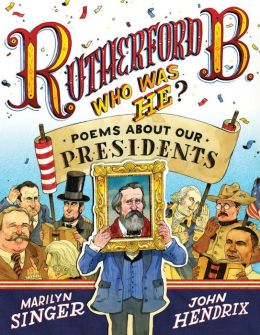 |
Rutherford B. Who Was He? Poems About Our Presidents Marilyn Singer Illustrated by John Hendrix Veteran author and poet Singer turns here to the forty-three men who have held the office of POTUS, giving each a swift, often irreverent poetic treatment. Like presidents, the verses are a varied lot: John Quincy Adams has a rollicking limerick-esque entry that notes “Folks found him a bother/ (as they did his father)”; Lincoln’s sparer stanza addresses his fame (“By stovepipe hat, beard, large size,/ he’s the one we recognize”); Nixon’s entry is one of Singer’s self-designed “reverso” poems, appropriate for setting his achievements against his ignominy. The poems often have the compactness of epitaphs but a more interesting complexity of meter and wordplay that makes them sophisticated choices for recitation or reading aloud; the literary portraits occasionally skip some key things (McKinley’s, for instance, doesn’t mention his assassination) but are more often surprisingly thorough in a few short lines. Hendrix’s visuals bring it all to life, with full-bleed mixed-media illustrations that combine the caricatured yet careful linework of political cartooning with crisply layered collagework. Quotes from the presidents become three-dimensional and intertwine with their scenes, while well-chosen details and clever approaches (Harrison and Cleveland play musical chairs, McKinley crouches in the shadow of Teddy Roosevelt) add perspective as well as amusement. This could be a springboard for performance, a way to spice up American History, or a Common Core-friendly entree into discussion about the merits of unorthodox presentation of fact. End matter includes a longer description of the office, a collection of presidential biographies, and a list of relevant books and websites. 2013, Disney/Hyperion, Grades 4-7, $17.99. REVIEWER: Deborah Stevenson (The Bulletin of the Center for Children’s Books). ISBN: 9781423171003 |
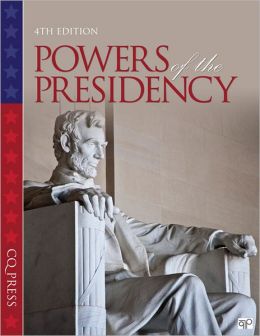 |
The Powers of the Presidency 4th Edition Editted by CQ Press Powers Of The Presidency is a good overall resource explaining the historical and constitutional authority and use for the powers of the executive branch. Details and examples are abundant and the book is clearly organized. “Powers” discussed by chapter include unilateral, head of state, chief administer, legislative leader, chief diplomat, commander in chief, and chief economist. The special, and sometimes contentious, relationship for sharing power between the executive and legislative branches is the main focus, demonstrating with definitive historical examples throughout U.S. history. Both 19th- and 20th-century presidencies are discussed; however, there is much more focus on the 20th century, especially from FDR onwards since that administration forward saw a huge expansion of presidential power. There are a few photos and some sidebars, as well as thorough notes at the end of each chapter, but it is a very text-heavy book. The discussion about presidential vetoes is a bit misleading for the Obama administration since the first term was not complete at the time this book was written and there were not any major bills passed by Congress to veto. The book does not qualify its facts by pointing out the aforementioned. The book will not be a poplar, general read but rather a good reference source since it is mostly well-researched and mostly unbiased, dry, historical fact. Overall, this book is worth purchasing for school and public libraries as a one-stop resource about the office of the presidency. 2012, CQ Press, Ages 11 to Adult, $50. REVIEWER: Karen Sykeny (VOYA). ISBN: 9781452226279 |
 |
The President Has Been Shot!” The Assassination of John F. Kennedy James L. Swanson In the vein of Swanson’s young adult adaptions Bloody Times: The Funeral Of Abraham Lincoln And The Manhunt For Jefferson Davis (HarperCollins, 2010/Voya June 2010) and Chasing Lincoln’s Killer (Scholastic, 2009/Voya December 2008), he again succeeds in the narrative nonfiction genre animating history for teens. With an introduction to Lee Harvey Oswald’s past, as well as John F. Kennedy’s rise to power and eventual presidency, the story is centered on the assassination, building suspense with rich descriptions, photographs, diagrams, and thoughtful chronological plotting. Swanson includes references to conspiracy theorists, possible motives, and the missteps taken by both Kennedy and his security detail during this time so as to present the material evenly. Once the gritty assassination occurs, Swanson then details the actions of Jackie Kennedy, successor Lyndon Johnson, and the assassin, and finally concludes the book with Oswald’s murder and Kennedy’s funeral. So much detail is packed into its pages that it begs to be shared, read, discussed, and dissected. It is as much a thriller as it is about romance, psychology, and politics. Swanson charms readers with mesmerizing, little-known facts, making readers the experts and inspiring them to become historians and inquirers. With appreciative readers, the hope is that Swanson will continue to publish for teens, with this latest being a valuable addition. 2013, Scholastic Press, Ages 12 to 18, $18.99. REVIEWER: Alicia Abdul (VOYA). ISBN: 9780545496544 |
 |
Presidential Pets: The Weird, Wacky, Little, Big, Scary, Strange Animals That Have Lived in the White House Julia Moberg Illustrated by Jeff Albrecht Studios From George Washington’s foxhound, parrot, and collection of other animals to Barack Obama’s Portuguese water dog, this nonfiction book relates details about all the presidents and their sometimes unusual pets. Two pages are devoted to each president with a full-page illustration, a poem, and sections called “Presidential Stats,” “Tell Me More,” and “Accomplishments and Events.” The rhyming verse in larger print contains some highlights about the pets. The stats are a listing of the president’s years in office and other important dates. The “Tell Me More” section gives specific information about the pets and other facts about the president. Details such as the fact that Lincoln’s son owned two goats, Nanny and Nanko, who were always chewing the furniture and eating the flowerbeds, provide interesting reading. Each president’s unique accomplishments are listed in the last section. The big and bold cartoon illustrations are intended to be humorous. All presidents are featured even if they did not own a pet. An index is included. The text contains lots of information and provides a look into the personal and professional lives of the presidents and would provide an entertaining reference source for libraries and schools. 2012, Imagine Books/Charlesbridge, Ages 9 to 12, $14.95. REVIEWER: Vicki Foote (Children’s Literature). ISBN: 9781936140794 |
 |
Presidential Races: Campaigning for the White House Arlene Morris-Lipsman Now in a fully updated and revised edition, “Presidential Races: Campaigning for the White House”, from the People’s History series, is an updated guide, overview, and commentary on the process of electing President of the United States of America, from the early beginnings in a post Jeffersonian era to the present day, with the election of President Barack Obama in November of 2008. Nine chapters condense changes in the process of campaigning for and winning election to the coveted oval office, with highlights from the 250 year history and additional emphasis on technological modifications, updates, and influences on the presidential races. The text of “Presidential Races” is complemented by a list of election results (1789-2008), source notes, selected bibliography, and further readings and websites. “Presidential Races” provides excellent political studies source material for students age 13 and up. Twenty-First Century Books, ages 13+, $33.26. RREVIEWER: Midwest Book Review (Children’s Bookwatch). ISBN: 9780761373957 |
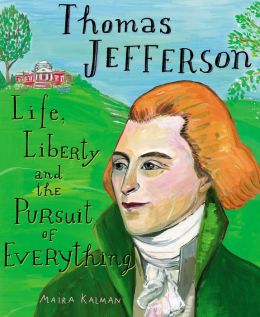 |
Thomas Jefferson: Life, Liberty and the Pursuit of Everything Maira Kalman Kalman turns her gaze on America’s third president, without the unconditional adoration she brought to Looking at Lincoln. Jefferson was “a terrible speaker but a great writer,” Kalman explains, lingering on his Declaration of Independence’s notions of equality: “It would be many years until most Americans were treated equally but it was the ideal on which America was founded.” Initially, Kalman focuses on Jefferson’s genius for collecting, architecture, and gardening, but halfway through, she reveals, “The man who said of slavery ‘This abomination must end’ was the owner of about 150 slaves. The monumental man had monumental flaws…. What did they do? Everything.” She pictures “the beautiful Sally Hemings” smiling and suggests that “some of” Jefferson and Hemings’s children “were freed and able to pass for white.” Other elephants in the room include Jefferson’s antiquated attitudes toward Native Americans and land grabs. Kalman dwells in conflict and raises questions to the end, pronouncing Monticello a symbol of all that is “optimistic and complex and tragic and wrong and courageous” about America. Includes author notes, not seen by PW. 2014, Nancy Paulsen Books, Ages 5-8. $17.99. REVIEWER: Publishers Weekly (Publishers Weekly). ISBN: 9780399240409 |
 |
Thomas Jefferson Builds a Library Barb Rosenstock Thomas Jefferson, writer of the Declaration of Independence and long regarded as a master with words, was fascinated with books and reading from childhood. He read plays, geographies, stories, poems, and prayers. He read when he walked and rode and played and even when he was supposed to be sleeping. Books fascinated him and as he read he collected. By the time he was a married man he built a special library in his home at Monticello and when his work took him to Europe he continued to collect and ship books home. While he was president he doubled the country’s size and tripled his library. In his home he had a revolving bookstand so he could read five books at a time. His love of books and his desire to share them resulted in a donation of his books that helped to create the Library of Congress. This is an imaginative and creative way to present the life of Jefferson. Written with humor and attention to detail, the engaging text moves at a frenetic pace–much like Jefferson, as he pursued his passion for books. The layout is busy with details giving the reader much to peruse and enjoy. Whimsical ink and watercolor illustrations capture the frivolous boy reading on horseback, the serious young politician off in a corner at the Continental Congress with his nose in a book, the tender husband reading to his dying wife, and the generous benefactor. Insets that appear on almost every page resemble open books contain quotes of Jefferson’s or additional biographical material. In an author’s note there is an acknowledgement of Jefferson’s position as a slaveholder. Whether kids love to read like Jefferson or need a gentle nudge to pick up a book, every reader will be fascinated and intrigued by this lively biography that deserves a place in every school and public library. 2013, Calkins Creek, Ages 7 to 12, $16.95. REVIEWER: Beverley Fahey (Children’s Literature). ISBN: 9781590789322 |
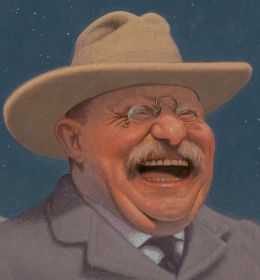 |
To Dare Mighty Things: The Life of Theodore Roosevelt Doreen Rappaport Illustrated by C.F. Payne Rappaport continues her series of biographies that emphasize direct quotations from their subjects (including Helen’s Big World and Abe’s Honest Words) by studying the setbacks and successes of Theodore Roosevelt. The author proceeds chronologically, noting Roosevelt’s sickliness as a child (as well as his love of animals, which continued through his life), before moving on to his two marriages, service in the New York State Assembly and other public positions, the Rough Riders’ taking of San Juan Hill, and his accomplishments as president, after ascending to office following the McKinley assassination. Payne provides hazy, burnished illustrations that alternately reflect Roosevelt’s seriousness of purpose (he’s shown lassoing a giant fist clutching money as he takes on corporate trusts), playfulness (as in a White House scene crawling with children and pets), and love of nature (Rappaport outlines how Roosevelt helped conserve “230 million acres” of American land). A timeline and suggestions for further reading round out a biography that, despite its brevity, gives a full sense of Roosevelt’s life. 2013, Disney Hyperion, Ages 6-8, $17.99. REVIEWER: Publishers Weekly (Publishers Weekly). ISBN: 9781423124887 |
 |
When Audrey Met Alice Rebecca Behrens In Behrens’s entertaining debut, 13-year old-Audrey Rhodes finds life as the President’s daughter stifling. Audrey’s big party is canceled over a security breach, her classmates only see her as “Fido” (short for First Daughter), her mother is busy running the country, and her father is occupied with cancer research. When Audrey discovers the hidden journal of former First Daughter Alice Roosevelt, “the nation’s first celebrity” (as Behrens puts it in an afterword) and a freewheeling wild child, she finds a kindred spirit. Audrey’s Alice-inspired adventures don’t always turn out well (like the flapper dress she wears to a state dinner), but they get Audrey on the road to “eating up the world,” as Alice likes to say. Alice’s (invented) journal entries appear throughout and offer a window into the life of this fearless historical figure though, as Behrens notes, “when it came to good fiction versus factual accuracy, fiction won.” Details of life in the White House, combined with Audrey’s more ordinary struggles (including the potential for a first boyfriend), will keep readers hooked. 2014, Sourcebooks Jabberwocky, Ages 9-up, $16.99. REVIEWER: Publishers Weekly (Publishers Weekly). ISBN: 9781402286421 |
 |
Where Do Presidents to Come From? And Other Presidential Stuff of Super Great Importance Michael Townsend Townsend fans will immediately recognize his familiar style in this graphic-novel-formatted title: manic bunnies and monkeys; smarty-pants kids with wide mouths, pointy teeth, and vacant Orphan Annie eyes; and a supporting crew of caricatures, robots, and talking objects. This time they are gathered in the service of teaching an election-year civics lesson on the presidency, its historical roots, its perks, and its problems. Townsend supplies the straight facts in a deadpan, mock-pedantic tone that gleefully contrasts with the send-ups of historical dramatis personae and the antic blather of the cartoon children soaking up the lessons. Since it’s no accident that the release date for this venture coincides with the run-up to this year’s election, kids can be forgiven if they skip over the background chapters on Washington and the Revolution and the separation of powers and cut right to the chase: who can run for office (no angry bunnies); who hung presidential underwear in the White House; what goes on at Camp David (“blah blah blah blah blah peace treaty”); and what’s the deal with this whole electoral college thing? Social studies teachers with a wacky streak who stick around long enough to see through the mayhem will appreciate the solid information and traditional almost stolid organization, complete with chapter reviews. Extra credit, kids? Review Code: R — Recommended. 2012, Dial, Grades 4-7, $14.99. REVIEWER: Elizabeth Bush (The Bulletin of the Center for Children’s Books). ISBN: 9780803737488 |
 |
White House Kids: The Perks, Pleasures, Problems, and Pratfalls of the President’s Children Joe Rhatigan With illustrations by Jay Shin The author introduces young readers to the presidential families. Readers view the White House through the eyes of the seventy children and grandchildren of the respective presidents. The material covers the perks, pleasures, problems, and pratfalls of the Presidents’ children from George Washington to Barack Obama. The Contents page defines the scope of the materials in the four chapters. These chapters address the First White House Kids, In the Spotlight, The Best Playground Available, and The Perks and Problems. An introductory section explains about Your New Address: 1600 Pennsylvania Avenue NW, Washington, DC 20500, and what is involved living there. Graphics, pastel-like artwork, and photographs enhance the text throughout the book. Sidebars with some of the photographs and graphics provide relevant information. Appendices include sections on “And Then What Happened?” and “The Presidents and First Ladies.” The Bibliography gives additional resources for further research. An Index provides easy navigation through the text. 2012, Imagine!, Ages 9 to 12, $14.95. REVIEWER: Annie Laura Smith (Children’s Literature). ISBN: 9781936140800 |
“The Leader of the Free World?” What does it take? Explore the Presidency, Presidents, and their families through fact and fiction.
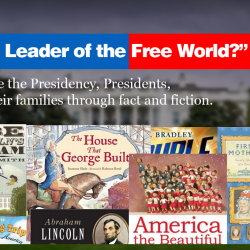
 |
What’s it like to be “The Leader of the Free World?” What does it take? Explore the Presidency, Presidents, and their families through fact and fiction.
Web links to additional information and activities about Presidents and the Presidency follow these reviews. Contributor: Peg Glisson |
Reviews
|



